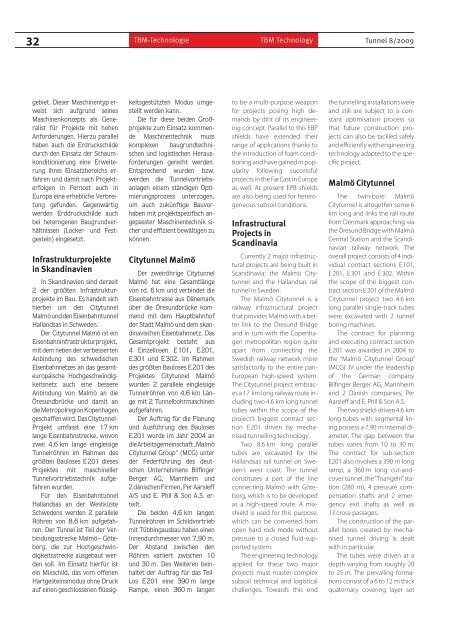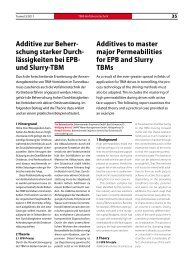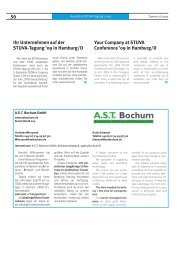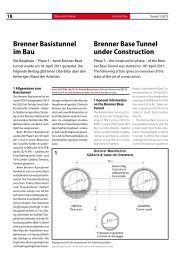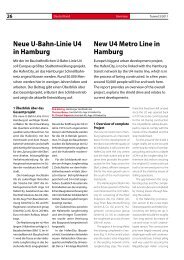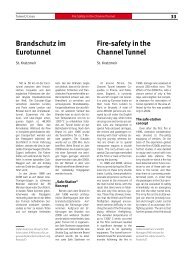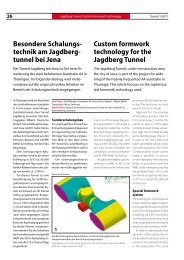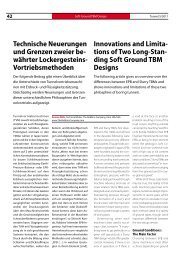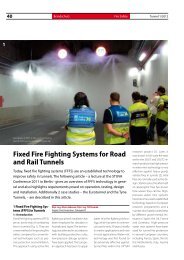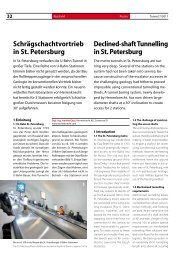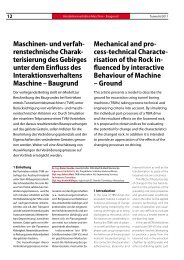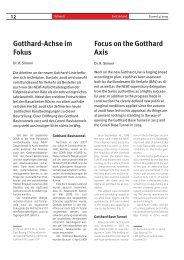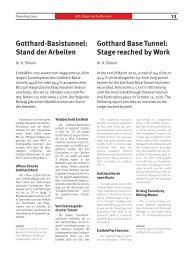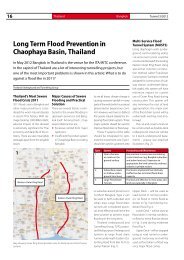Maschinentechnische Neuerungen bei Mix- schild- und ... - Tunnel
Maschinentechnische Neuerungen bei Mix- schild- und ... - Tunnel
Maschinentechnische Neuerungen bei Mix- schild- und ... - Tunnel
Erfolgreiche ePaper selbst erstellen
Machen Sie aus Ihren PDF Publikationen ein blätterbares Flipbook mit unserer einzigartigen Google optimierten e-Paper Software.
32 TBM-Technologie TBM Technology <strong>Tunnel</strong> 8/2009<br />
gebiet. Dieser Maschinentyp erweist<br />
sich aufgr<strong>und</strong> seines<br />
Maschinenkonzepts als Generalist<br />
für Projekte mit hohen<br />
Anforderungen. Hierzu parallel<br />
haben auch die Erdruck<strong>schild</strong>e<br />
durch den Einsatz der Schaumkonditionierung<br />
eine Erweiterung<br />
ihres Einsatzbereichs erfahren<br />
<strong>und</strong> damit nach Projekterfolgen<br />
in Fernost auch in<br />
Europa eine erhebliche Verbreitung<br />
gef<strong>und</strong>en. Gegenwärtig<br />
werden Erddruck<strong>schild</strong>e auch<br />
<strong>bei</strong> heterogenen Baugr<strong>und</strong>verhältnissen<br />
(Locker- <strong>und</strong> Festgestein)<br />
eingesetzt.<br />
Infrastrukturprojekte<br />
in Skandinavien<br />
In Skandinavien sind derzeit<br />
2 der größten Infrastrukturprojekte<br />
im Bau. Es handelt sich<br />
hier<strong>bei</strong> um den Citytunnel<br />
Malmö <strong>und</strong> den Eisenbahntunnel<br />
Hallandsas in Schweden.<br />
Der Citytunnel Malmö ist ein<br />
Eisenbahninfrastrukturprojekt,<br />
mit dem neben der verbesserten<br />
Anbindung des schwedischen<br />
Eisenbahnnetzes an das gesamteuropäische<br />
Hochgeschwindigkeitsnetz<br />
auch eine bessere<br />
Anbindung von Malmö an die<br />
Öres<strong>und</strong>brücke <strong>und</strong> damit an<br />
die Metropolregion Kopenhagen<br />
geschaffen wird. Das Citytunnel-<br />
Projekt umfasst eine 17 km<br />
lange Eisenbahnstrecke, wovon<br />
zwei 4,6 km lange eingleisige<br />
<strong>Tunnel</strong>röhren im Rahmen des<br />
größten Bauloses E 201 dieses<br />
Projektes mit maschineller<br />
<strong>Tunnel</strong>vortriebstechnik aufgefahren<br />
wurden.<br />
Für den Eisenbahntunnel<br />
Hallandsas an der Westküste<br />
Schwedens werden 2 parallele<br />
Röhren von 8,6 km aufgefahren.<br />
Der <strong>Tunnel</strong> ist Teil der Verbindungsstrecke<br />
Malmö– Göteborg,<br />
die zur Hochgeschwindigkeitsstrecke<br />
ausgebaut werden<br />
soll. Im Einsatz hierfür ist<br />
ein <strong>Mix</strong><strong>schild</strong>, das vom offenen<br />
Hartgesteinsmodus ohne Druck<br />
auf einen geschlossenen flüssigkeitsgestützten<br />
Modus umgestellt<br />
werden kann.<br />
Die für diese <strong>bei</strong>den Großprojekte<br />
zum Einsatz kommende<br />
Maschinentechnik muss<br />
komplexen baugr<strong>und</strong>technischen<br />
<strong>und</strong> logistischen Herausforderungen<br />
gerecht werden.<br />
Entsprechend wurden bzw.<br />
werden die <strong>Tunnel</strong>vortriebsanlagen<br />
einem ständigen Optimierungsprozess<br />
unterzogen,<br />
um auch zukünftige Bauvorhaben<br />
mit projektspezifisch angepasster<br />
Maschinentechnik sicher<br />
<strong>und</strong> effizient bewältigen zu<br />
können.<br />
Citytunnel Malmö<br />
Der zweiröhrige Citytunnel<br />
Malmö hat eine Gesamtlänge<br />
von rd. 6 km <strong>und</strong> verbindet die<br />
Eisenbahntrasse aus Dänemark<br />
über die Öres<strong>und</strong>brücke kommend<br />
mit dem Hauptbahnhof<br />
der Stadt Malmö <strong>und</strong> dem skandinavischen<br />
Eisenbahnnetz. Das<br />
Gesamtprojekt besteht aus<br />
4 Einzellosen E 101, E 201,<br />
E 301 <strong>und</strong> E 302. Im Rahmen<br />
des größten Bauloses E 201 des<br />
Projektes Citytunnel Malmö<br />
wurden 2 parallele eingleisige<br />
<strong>Tunnel</strong>röhren von 4,6 km Länge<br />
mit 2 <strong>Tunnel</strong>bohrmaschinen<br />
aufgefahren.<br />
Der Auftrag für die Planung<br />
<strong>und</strong> Ausführung des Bauloses<br />
E 201 wurde im Jahr 2004 an<br />
die Ar<strong>bei</strong>tsgemeinschaft „Malmö<br />
Citytunnel Group“ (MCG) unter<br />
der Federführung des deutschen<br />
Unternehmens Bilfinger<br />
Berger AG, Mannheim <strong>und</strong><br />
2 dänischen Firmen, Per Aarsleff<br />
A/S <strong>und</strong> E. Phil & Son A.S. erteilt.<br />
Die <strong>bei</strong>den 4,6 km langen<br />
<strong>Tunnel</strong>röhren im Schildvortrieb<br />
mit Tübbingausbau haben einen<br />
Innendurchmesser von 7,90 m.<br />
Der Abstand zwischen den<br />
Röhren variiert zwischen 10<br />
<strong>und</strong> 30 m. Des Weiteren <strong>bei</strong>nhaltet<br />
der Auftrag für das Teil-<br />
Los E 201 eine 390 m lange<br />
Rampe, einen 360 m langen<br />
to be a multi-purpose weapon<br />
for projects posing high demands<br />
by dint of its engineering<br />
concept. Parallel to this EBP<br />
shields have extended their<br />
range of applications thanks to<br />
the introduction of foam conditioning<br />
and have gained in popularity<br />
following successful<br />
projects in the Far East in Europe<br />
as well. At present EPB shields<br />
are also <strong>bei</strong>ng used for heterogeneous<br />
subsoil conditions.<br />
Infrastructural<br />
Projects in<br />
Scandinavia<br />
Currently 2 major infrastructural<br />
projects are <strong>bei</strong>ng built in<br />
Scandinavia: the Malmö Citytunnel<br />
and the Hallandsas rail<br />
tunnel in Sweden.<br />
The Malmö Citytunnel is a<br />
railway infrastructural project<br />
that provides Malmö with a better<br />
link to the Öres<strong>und</strong> Bridge<br />
and in turn with the Copenhagen<br />
metropolitan region quite<br />
apart from connecting the<br />
Swedish railway network more<br />
satisfactorily to the entire pan-<br />
European high-speed system.<br />
The Citytunnel project embraces<br />
a 17 km long railway route including<br />
two 4.6 km long tunnel<br />
tubes within the scope of the<br />
project’s biggest contract section<br />
E 201 driven by mechanised<br />
tunnelling technology.<br />
Two 8.6 km long parallel<br />
tubes are excavated for the<br />
Hallandsas rail tunnel on Sweden’s<br />
west coast. The tunnel<br />
constitutes a part of the line<br />
connecting Malmö with Göteborg,<br />
which is to be developed<br />
as a high-speed route. A mixshield<br />
is used for this purpose,<br />
which can be converted from<br />
open hard rock mode without<br />
pressure to a closed fluid-supported<br />
system.<br />
The engineering technology<br />
applied for these two major<br />
projects must master complex<br />
subsoil technical and logistical<br />
challenges. Towards this end<br />
the tunnelling installations were<br />
and still are subject to a constant<br />
optimisation process so<br />
that future construction projects<br />
can also be tackled safely<br />
and efficiently with engineering<br />
technology adapted to the specific<br />
project.<br />
Malmö Citytunnel<br />
The twin-bore Malmö<br />
Citytunnel is altogether some 6<br />
km long and links the rail route<br />
from Denmark approaching via<br />
the Öres<strong>und</strong> Bridge with Malmö<br />
Central Station and the Scandinavian<br />
railway network. The<br />
overall project consists of 4 individual<br />
contract sections E 101,<br />
E 201, E 301 and E 302. Within<br />
the scope of the biggest contract<br />
section E 201 of the Malmö<br />
Citytunnel project two 4.6 km<br />
long parallel single-track tubes<br />
were excavated with 2 tunnel<br />
boring machines.<br />
The contract for planning<br />
and executing contract section<br />
E 201 was awarded in 2004 to<br />
the “Malmö Citytunnel Group”<br />
(MCG) JV <strong>und</strong>er the leadership<br />
of the German company<br />
Bilfinger Berger AG, Mannheim<br />
and 2 Danish companies, Per<br />
Aarsleff and E. Phil & Son A.S.<br />
The two shield-driven 4.6 km<br />
long tubes with segmental lining<br />
possess a 7.90 m internal diameter.<br />
The gap between the<br />
tubes varies from 10 to 30 m.<br />
The contract for sub-section<br />
E201 also involves a 390 m long<br />
ramp, a 360 m long cut-andcover<br />
tunnel, the “Triangeln” station<br />
(280 m), 4 pressure compensation<br />
shafts and 2 emergency<br />
exit shafts as well as<br />
13 cross-passages.<br />
The construction of the parallel<br />
bores created by mechanised<br />
tunnel driving is dealt<br />
with in particular.<br />
The tubes were driven at a<br />
depth varying from roughly 20<br />
to 25 m. The prevailing formations<br />
consist of a 6 to 12 m thick<br />
quaternary covering layer set


